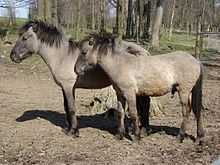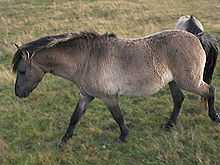Heck horse
 Two Heck horses in the zoo of Stadt Haag, Austria | |
| Country of origin | Germany |
|---|---|
| Horse (Equus ferus caballus) | |

The Heck horse[1]) is a horse breed that is claimed to resemble the extinct wild equine, the Tarpan, (Equus ferus ferus). The breed was created by the German zoologist brothers Heinz Heck and Lutz Heck, director of the Berlin Zoo, at the Tierpark Hellabrunn (Munich Zoo) in Germany in their attempt to breed back the tarpan. The first foal born from the program was a colt born on May 22, 1933 at the Tierpark Hellabrunn.[2][3]
History
The Hecks believed they could recreate the extinct tarpan subspecies by back breeding living descendants.[4] They believed they could combine and rearrange the genetic material from these living descendants into a recreation of the extinct horse.[2]
The Heck brothers bred together several European small horse and pony breeds hypothesized to be descended from the tarpan. They used mares of the Konik, Icelandic horse, and Gotland breeds. These mares were bred to stallions of a wild horse type known as Przewalski's horse. The Hecks believed the wild Przewalski blood would help to draw out the wild characteristics they felt lay dormant in the domesticated pony breed mares.[2]
The first Heck horse in the United States, a stallion named Duke, was imported in 1954 by the Chicago Zoological Park in Illinois, followed by two mares in 1955. A third mare was imported by the Fort Worth Zoological Park in Texas in 1962. All four horses came from the Munich Zoo and all Heck horses in the United States trace back to these animals. Several private breeders in the United States now use their horses for riding and light driving.[2] In the early 1960s, the North American Tarpan Association was founded by Heck horse enthusiasts to promote the breed.[5]
Several breeders have crossed the Heck horse with other breeds to get a larger horse with some of the primitive characteristics. Breeds that are commonly crossed with the Heck horse are the Welsh pony and Arabian horse, and a new breed of pony, called the Canadian rustic pony, has been developed from these three breeds. In Europe, many breeders cross Heck horses with Thoroughbreds to produce hunters.[2]
Breed characteristics
Heck horses are dun or grullo (a dun variant) in color, with no white markings. The breed has primitive markings, including a dorsal stripe and zebra markings on the legs. Heck horses generally stand between 12.2 and 13.2 hands (50 and 54 inches, 127 and 137 cm) tall. The head is large, the withers low, and the legs and hindquarters strong. The hooves are strong, often not needing shoeing. The gait of the Heck horse is high stepping, which makes them comfortable to ride and attractive when being driven.[6] The breed is described as being calm, friendly, curious and intelligent, although very independent.[2]
See also
References
- ↑ "Main page". North American Tarpan Association. Retrieved 2009-02-02. "Lost in the misty memory of Eastern Europe, the ancient Tarpan vanished so quietly that its passing was hardly noticed. Then, through the efforts and expertise of German Zoologist Heinz Heck, a new horse emerged from the grey haze of history, to remind us of the beauty of what we had lost. In the process, a unique little horse was created. The NATA's mandate is to preserve this Tarpan, to promote it's [sic] endearing traits of gentleness, strength and hardiness, and to protect it's [sic] complex and fascinating history."
- ↑ 2.0 2.1 2.2 2.3 2.4 2.5 "Tarpan, Breeds of Livestock". Oklahoma State University. Retrieved January 13, 2009.
- ↑ "Equus ferus ferus". The Extinction Website. Retrieved January 13, 2009.
- ↑ Heck, H. (1952). "The Breeding-Back of the Tarpan". Oryx 1 (7): 338. doi:10.1017/S0030605300037662.
- ↑ About Us, North American Tarpan Association, accessed January 13, 2009.
- ↑ Standard, North American Tarpan Association, accessed January 13, 2009.
External links
| Wikimedia Commons has media related to Heck horse. |
| ||||||||||||||||||||||||||||
| |||||||||||||||||||
.jpg)